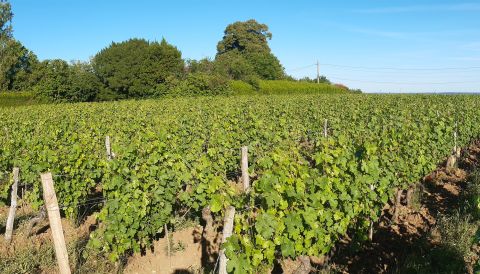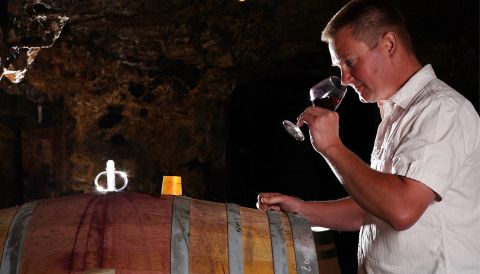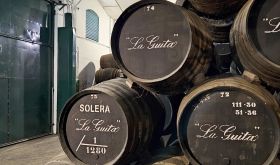Last week David Duncan, owner of Silver Oak in Napa, introduced me to the most helpful scoring system for wine I’ve ever encountered. ‘It’s a five-point scale’, he said, looking mischievous. ‘YUMMY’, he finished, enjoying the confused look on my face before explaining.
Y is for Why? As in why bother?
YU is You might like it but I don’t.
YUM is yum, solid, a good tailgate choice.
YUMM is really enjoyable; I’d buy it again.
YUMMY is just that – yummy!
At the time we were drinking water, so I can’t speak to how many letters his wine earns. But his scoring system has stuck with me as I’ve tasted everything since – wine or food – because I love it for its reflexivity, its honesty. Yummy is a reaction that comes from the gut, not the cerebrum, and, as much as I like my wines to inspire thought, their very first responsibility is to fulfil the quest for deliciousness.
Which is exactly what Domaine Guion’s 2020 Cuvée Candide from Bourguiel does, with a capital YUMMY.
This is a wine that came to me entirely unexpected, a glass handed to me without any explanation, in the middle of a conversation. I sipped it absentmindedly, and woosh – in that moment everything stopped, all thoughts and feelings realigning around the wine in the glass. It’s cherries and fir forests, berries and spice. It’s cool and juicy, with pleasantly gravelly tannins that hold the flavours long. At 12% alcohol, it’s the perfect weight for drinking on its own (as I was) but it’s also fantastically versatile, proving to be a terrific match with a lentil-and-sausage salad one night and saag paneer another.
Later, thinking about the wine with my head instead of my gut, I realised that the clarity of the flavours is what’s most arresting. One sip conjured up a picture of a place – a green, foresty place, lush and healthy in its flora, and possibly hiding some equally healthy fauna. It was transporting, conjuring a vista vastly different than the one out my fourth-floor walk-up. It’s real wine, deliciously juicy and full of flavour but also very much of a place, with a distinct identity. And it has depth and structure; if I had the cellar space, I’d tuck some bottles away for another 5–10 years.
The image it imprints made sense when I learned that the wine is from Bourgeuil, a red-wine appellation on the north bank of the Loire, across from Chinon. Domaine Guion is situated right in the heart of the appellation, set back from the river, in Benais (see this World Atlas of Wine map). The soils here are Turonian, a division of the Cretaceous – meaning that this area was once under a shallow sea teaming with life, which left behind lots of calcium-rich stones – tuffeau, mainly, and other sorts of limestone.
The Guions began farming here in the 1950s, before synthetic fertilisers, herbicides and insecticides made inroads here. When they did begin to become common, the family resisted. ‘You had to be very strong at that time’, Stéphane, the current owner, says of his parents, ‘but they remained faithful to natural techniques in the interest of product quality and life.’ In 1965, they began following the Lemaire-Boucher method, an organic practice pioneered in the Loire in the early 1960s (you can find a few more details on the method from Monty Waldin’s site); they also raised pigs, cows and horses as well as farming a host of vegetables and grains.
Stéphane, however, took a special interest in the vines, and left to study winemaking in Bordeaux and other parts of the Loire before returning home to take over when his parents retired in 1994. Since then, Guion has focused primarily on vine-growing and winemaking, farming nearly 10 ha of vineyards (9.5 ha/23 acres of Cabernet Franc and 0.3 ha/0.7 acre of a new planting of Chenin Blanc), the Franc vines aged from 10 to 80 years. He’s remained committed to organic farming (certified by Ecocert) and has embraced biodynamics as well (Demeter-certified in 2021). The older vines go into Cuvée des Deux Monts and Cuvée Prestige/Authentique; the younger go into the Candide (formerly called simply Domaine). Both wines get the same care in the vineyard and winery, with ambient-yeast ferments and only very little added SO2. He stores his bottles in a cool, damp 5-km labyrinth of caves dug into the limestone under Benais that was once a quarry and later a mushroom farm; it is now shared among 10 wine producers.
How the wine can be so good and sell for so little is the real question – one I asked David Lillie of Chambers Street Wines, who was the first person in the US to sell his wines, back in 2009. ‘He's very quiet and shy, not one of the Loire Valley hipsters at all, sort of a crew-cut, youthful look’, he told me. ‘Every year I tell him how great his wines are and he just blushes. And I tell him to raise his prices which are insanely low given his work and the quality of the wines.’
When I asked Guion, his answer was quite straightforward: ‘We have always charged “reasonable” prices because I think wine is meant to be shared!! [And] by as many people as possible and not reserved for certain people.’
To that end, Guion exports 70% of his production, selling it everywhere from Ontario and Manitoba in Canada to Japan, Switzerland, Ireland, Portugal, Belgium, the Netherlands, Denmark and Austria. In the US, the wine is imported by Fruit of the Vine, NY, and Percy Selections, CA, among others; in the UK, it is imported by Indigo Wines.
The only caveat is that Guion doesn’t make a lot of wine, and those in the know tend to snap up the bottles as soon as they land. But if you miss out on the 2020, the 2022 is coming in soon, and Guion recently introduced a traditional-method Cabernet Franc-based sparkling wine he calls Bête de Benais, a play on the bête de Benais, a wolf-like creature that terrorised the countryside in the 1690s, which is sure to keep your thirst slaked until the next shipment of Cuvée Candide.
Members can also access nearly 4,000 reviews of Loire wines in our tasting notes database.

















